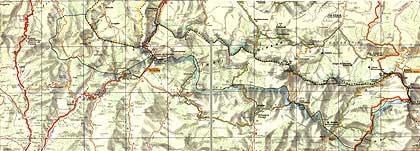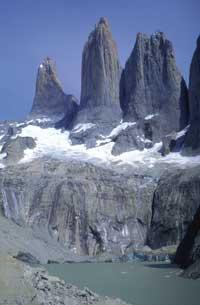Nomadic residence
2000/05/28 Carton Virto, Eider - Elhuyar Zientzia
In the United States Glacier National Park there were about 150 large glaciers in 1850. Only 37 have remained to date, but they are also melting and the speed carried by glaciers could disappear completely by 2050. Melting glaciers is not the only problem in Montana park. Rivers and streams receive less and less snow in spring and some are tempering, threatening the life of basic invertebrates in the food chain of endangered trout. The streams that dry in mid-summer are becoming more and more numerous, many of them emptied depending on the rain and converted into full wells. The area of the Park's wetlands is declining, leaving uneaten animals, birds, bears and others feeding on houses and basasaguas.
The climate change that the Glacier National Park is experiencing is nothing more than a picture of the problem of conservation biologists around the world, since the same problem has appeared in all areas where the warming of the planet has a special incidence. National parks, nature reserves or wildlife refuges preserve animal and plant ecosystems, but with rising temperatures, if residents decide to migrate, how can they meet their obligation?
Methodology
Climate change requires new rules for the management of natural parks, since according to studies, a fifth of the world's largest natural reserves can have a totally different landscape within 30 years. In Canada, for example, the impact will be very large. The local climate has driven cold-loving animals, such as caribou and polar bear, but as the temperature increases, these animals can receive an unpleasant surprise. Canada, for its part, has 39 types of environments, of which 24 are declared natural parks. However, if the limits of the means change with the climate, in the course of the years natural parks can protect areas that have nothing to do with the ecosystems that initially protected; over time, the means to conserve can migrate to another place.
In addition to melting glaciers, sea level rise can cover protected swamps and large pastures can disappear by pressure from invading trees. In the forest of Monteverde Hodei, in Costa Rica, birds and amphibians have disappeared along with the humidity generated by the clouds that have escaped to the summits of the mountain. This is the case in many regions of the world. Global warming can destroy many protected ecosystems, but even though environmentalists are informed, little or nothing has been done to address the problem.
For 15 years, scientists began to worry about the fate of protected ecosystems on a warmer planet, but for those who have to watch over these parks, the daily struggle and extension of non-native species is a challenge that manifests itself far away in this climate change and requires decades of development.
Researchers and ecologists try to find in the past the keys to the future. The climate changes that have previously occurred on Earth are being investigated through the rings of animals and trees, while others are collecting and analyzing the changes that have already occurred in the parks and a few are looking for solutions, inventing new ways of designing natural reserves and collaborating with the owners of the land located within these protected spaces.
The past, for example, has something to tell. Ecological communities are not harmonized to the north (or to the sky in the case of mountains) in search of more humid or cold regions; on the contrary, climate change is much like the explosion of fireworks: the ecosystem breaks into a thousand pieces and animals and plants flee in different directions, according to their needs. Something like this happened in the Rocky Mountains of Colorado between 400,000 and 800,000 years ago, but these changes are not always harmful, guilty of the rich flora and fauna of the current Rocky Mountains to a restructuring of that time.
Natural corridors
The next restructuring, however, will be totally different from all previous ones. In the past, living beings had entire continents to pass freely in search of humid, cold, dry or hot regions. Today, on the contrary, there are rural houses, barriers and cities, and since animals and plants have not gone where to go, their duration can be threatened if climate change transforms the place of residence. Therefore, there are those who propose the creation of corridors that connect the natural reserves with each other so that the animals can move from the pastures. In Europe they want to create "reserve networks", it has been suggested that the land of the power lines that cross the whole country of Israel be used as corridors to collect moving animals from one habitat to another. Few of these ideas have gone from paper to reality.
Regardless of the initiatives being carried out, it is clear that some parks will not be able to protect their species and habitats for a long time (since they will not be in the place of the park) but the key is the identification of these parks, since the current climate models are too general and are not valid for a specific nature reserve. And although the future of certain species can be predicted based on physiology or current distribution, the important thing is to know how species interactions will change, and this is very difficult to predict. The seed of endangered trees can be transported to more favorable climate regions, but the movement of the entire group of animals can be very laborious. Therefore, if there are species that cannot move, can reserves be designed to be mobile? One way to do this is to choose the regions that go from north to south (the axis of the traditional parks is from east to west), so that if the climate of an area is heated, the animals can access cooler lands of the north. Also, reserves can be complemented with areas with high and low altitude lands, with the need for animals to climb to cooler and probably more humid areas.
The consideration of these principles when designing new natural reserves is a way to combat climate change, which must also be considered from now on. Otherwise, the work done for years in the selection and implementation of natural reserves could be empty. Natural spaces that were designated to protect wildlife, but may not be able to fulfill their role. The time has come to wake up.
Threatened parks
Arctic National Wildlife Refuge (USA) If Permafrost melts the tundra may disappear
Northeastern Greenland Higher snowfall can delay spring and shorten bird reproductive age
Yellowstone National Park, USA Large fires caused by warmer and drier weather threaten the forests of yesteryear
Everglades National Park, USA Sea level rise and rising storms can damage this ecosystem
Belize's Barrier Reef, Caused by Belize's Warm Water Disease at the Second Great Barrier Reef
Manu, Peru Hodei increases risk of disappearance of fog forests
Waddenzee, Herbehera Sea level rise can cover this rich wetland
Swiss National Park quickly melts glaciers
Majella, Italy The reduction of snowfall can make disappear regions covered with wild pine
Change in the water circulation pattern of Lake Malawi can reduce productivity and endanger fish species endemic to the lake
Moremi Game Reserve, Botswana The driest and warmest weather will bring less water to these flood lands for the rich native flora and fauna
Whale Sanctuary, Antarctica Warmer waters can reduce the population of krill (small shrimp), the main food of whales
Pechoro-llych Reserve, Russia Warmer summers cause proliferation of beetles that destroy boreal forests
The Wolong Nature Reserve, China Panda and other species may be threatened by the migration of their climatic spaces.
The filling of Sagarmatha, the water of the melting glaciers of Laguna Nepal, can cause huge floods
Kanha, the weakest Indian monsoon can endanger the humid forests where the tiger lives
Kutai, Indonesia Drought and fires destroy most of its forests
Kakadu, Australia Sea level rise can send salt water to the rivers and wetlands of the Netherlands
Published in the supplement Natura de Gara

Gai honi buruzko eduki gehiago
Elhuyarrek garatutako teknologia





